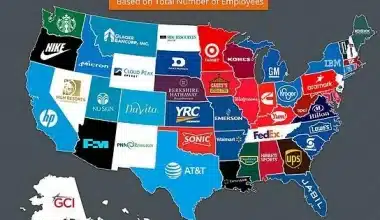Businesses strive to increase their market share and win trust. Corporate branding assists businesses in establishing themselves in the marketplace, retaining existing clients, and attracting new buyers.
Your company’s identity, communication style, marketing strategy, and other assets are all part of its branding. Reviewing and refining your corporate branding can assist you in developing your company’s brand voice and distinguishing yourself from the competition. We’ll discuss crucial information and examples of corporate branding strategy, as well as how refining your branding process can benefit your business.
What is Corporate Branding?
Corporate branding is the image or identity of a firm and how it is presented to customers. The brand of a firm often represents its values, brand voice, and messaging. Marketing experts frequently create corporate brands to represent how they want employees and customers to perceive the corporation.
When deciding on a corporate brand image, it’s critical to maintain consistency by featuring your company’s logo, messaging, image, style, and voice in all marketing materials on a frequent basis. This distinguishes the company from the competition and makes it more noticeable to potential customers.
Logo vs. Brand
While both a brand and a logo represent a firm, they are distinct concepts that are essential components of a company’s image. A company’s brand often identifies the company’s purpose, the product or service it offers, the audience to whom it sells, and why that product or service is sold.
Your logo is a visual representation of your company and brand. People usually think of your brand and its messaging when they see your logo. Placing your logo on your marketing and sales materials on a regular basis will help consumers remember your brand and raise awareness for new customers.
The Importance of Corporate Branding
Corporate branding is vital because it allows you to describe the personality, traits, values, and purpose of your company. Customers may prefer your product or service above others because they like your mission, believe in the cause, and share similar beliefs. When you relate to a firm, you may use emotional marketing to get people to trust, rely on, and commit to the brand. Building these deep connections through corporate branding can result in greater client retention, referrals, and revenue.
Types of Corporate Branding
Types of corporate branding are not included in the definition of corporate branding. They are, nonetheless, necessary for this notion and play an important part in assisting firms in determining what corporate branding materials they require and what corporate branding strategy to employ in order to achieve short-term and long-term goals.
The following are the most prevalent methods of corporate branding that are worth exploring and attempting in your efforts to increase market share:
- Personal Branding: It refers to the process of branding a person or business.
- Product Branding: It is used to promote a single product.
- Geographical Branding: It refers to advertising a company based on a collection of distinctive characteristics of a given place.
- Cultural Branding: It refers to advertising a brand based on a set of distinct cultural characteristics.
- Services Branding: It refers to actions that improve user experience and customer service in order to best resonate with the market.
- Internet Branding: It relates to the company’s positioning in digital expanses.
- Offline Branding: It refers to the company’s real-world positioning.
- Co-branding: It refers to collaborations with other companies in order to maximize comparable market positions.
How To Develop a Corporate Branding Strategy?
A corporate branding strategy improves consistency and enhances the presence of your organization. This branding strategy might assist you in gaining market share and increasing consumer loyalty. We’ll go over the components of an effective corporate branding strategy.
#1. Make a list of your mission, vision, and values.
Your mission statement, brand values, and vision help stakeholders and customers understand your business. This basic corporate branding identity is an ideal beginning point for your business.
#2. Study your present corporate identity.
Understand how you now communicate with clients and discuss your offerings. Too many executives are solely concerned with financial objectives, with little regard for what the public thinks of the organization. Corporations become prone to failure when they cease to care what their customers think.
#3. Define your consumers’ requirements.
Customers require footwear as well as smartphones. They purchase from Apple and Nike due to their excellent products and corporate identities. You must still deliver a useful product or service, but your client’s needs go beyond those concepts. Do your clients care about social justice, family time, and other issues? Determine what your customers require and which of those requirements should be incorporated into your corporate branding.
#4. Create an open channel of communication with coworkers for guidelines.
A corporate brand identity has an impact on both executives and employees. Some employees have more experience communicating with potential consumers, meeting their needs, and handling complaints. Your coworkers can provide valuable insights that can help shape your corporate branding strategy.
The Benefits of Corporate Branding
So, why should you invest in a corporate branding strategy? Let’s take a look at three significant advantages of corporate branding.
#1. Establish Your Personality
The personality of your brand is defined by corporate branding.
What characteristics does your brand represent? Does it, like Wendy’s or KFC, have a sense of humor? Perhaps your brand is colorful and friendly, distinguished, concerned with sustainability, and so on.
Customer loyalty increases when your target audience connects with your company’s personality and feels a connection with your brand, which presents a wonderful possibility for higher sales.
#2. Ensure Consistency in Your Offerings
Corporate branding allows your company to implement a coordinated and uniform marketing strategy across all of its offerings.
For example, suppose you own a tech company and present yourself as an inventive industry leader while simultaneously emphasizing simplicity (hello, Apple)!
Implementing a corporate branding strategy enables you to brand each of your items in a consistent manner: basic (with a minimalistic design) yet modern (adding the most recent technological breakthroughs, such as artificial intelligence for face recognition if you sell mobile phones).
#3. Save Money And Time
As previously stated, corporate branding allows you to save time and money in your branding and marketing activities. You won’t have to develop a fresh game plan for each new product launch.
Tips for Maintaining a Strong Brand
Following the creation of a corporate brand, it is critical to maintain consistency because this helps the brand become more familiar to consumers. Here are some suggestions for sustaining a corporate brand:
#1. All marketing initiatives should be coordinated.
To ensure consistency, use the same messaging across all marketing pieces. Use social media accounts, for example, to reflect the brand’s ideals. This may entail interacting with specific content or responding in a manner defined by the brand style guide.
#2. Study rival brands.
It is beneficial to conduct competitor brand research to learn how they develop their corporate brand. You may monitor how competitors express their brand identity to consumers and how people react to it through research. These insights can help you develop your own brand strategy by incorporating features that work in your market.
#3. Make visuals
Visual aids frequently aid in the retention of knowledge. This is why having images to reflect your brand is beneficial. To assist reflect the brand, consider the brand logo, colors, typefaces, and other assets that accompany postings on brand social networks. You may keep the brand alive by attempting to infuse brand imaging into every touchpoint between the organization and its customers.
Examples of the Best Corporate Branding
While some examples compare and contrast corporate brands vs. product brands, we will concentrate on effective branding examples.
#1. Apple
Apple will be our first point of reference. It is one of the best examples of corporate branding in the world. Why? It has, however, made the most of this marketing approach, revamping some of its practices in the process.
Apple’s branding strategy is centered on providing value to customers, fulfilling current standards, enhancing its reputation, and setting trends. It also pays off. The company is a well-known trendsetter, with several of its products functioning as synonyms for specific niches.
Their reputation always helps with product launches and other types of promotions.
As a result, the corporation asks for what they are worth, even if the tag prices are slightly overstated.
#2. Tesla
Tesla is one of the world’s most inspiring corporate branding goods. It grabbed the market by storm many years ago and is expected to produce $53.8 billion by 2021.
This automaker is also synonymous with the entire category. Despite the fact that it was not the first to bring the electric car to the public, it has successfully carved out a niche for itself.
Their branding strategy is built on the intelligent marketing of high-quality and special features via all distribution channels, as well as the use of social media and advertisement campaigns. They present themselves as a one-of-a-kind company that establishes the next global trend.
#3. Nike
Among several examples of firm branding, this one gets the top spot. It was able to accomplish crucial things thanks to a well-thought-out corporate branding strategy, such as:
Invented the phrase “Just Do It,” which became a catchphrase for millions of athletes worldwide.
Gave their logo a name, making it well-known among the public.
It became synonymous with the sports category.
As a result, the corporation’s revenue last year was $37.40 billion.
However, the company’s success did not come easily. From finding the perfect voice to teaching the crowd how to pronounce the brand name correctly to long-term partnerships with notable athletes and celebrities, the brand team is continually investing in branding.
#4. Microsoft
Microsoft clearly stands out among many successful examples of corporate branding. It’s been with us for a long time and it still rocks. Some of its items, like those listed above, can be considered synonyms for specific categories.
The fact that the corporation owns a number of consumer brands is the secret ingredient in its branding. As a result, it belongs to two Worlds at some point. It is a consumer as well as a corporate brand. However, thanks to the intelligent strategy of sharing the same values and remaining consistent with the message, the corporation has a solid position and one of the market’s largest revenues, $161 billion.
#5. Amazon
Amazon is the most powerful corporate branding example in the digital world, particularly in the e-commerce specialty. It is even a term for electronic commerce. This international corporation is also involved in cloud computing, digital streaming, and artificial intelligence.
It shifted from a digital store to a sales platform in 2000 and generated a record $469.822 billion in revenue last year. Clever rebranding and continual changes and additions to brand strategy assisted this company in beating the competition and becoming one of the world’s most successful enterprises.
The secret ingredient is that the team maintains consistency across consumer, customer, and employer sub-brands, reinforces the brand image on a regular basis, and offers products and services that meet the needs of an ever-changing market.
Conclusion
According to recent surveys, there are 213.65 million firms in the world today, with the vast majority of them being well-established corporate brands.
Corporate branding can take a business to the next level by providing a variety of benefits, whether it is a local business, a digital startup, or a large multinational conglomerate. For example, it distinguishes the company from competitors, promotes items, improves reputation, boosts credibility, establishes a solid base for numerous marketing initiatives, and raises revenue. Not only that, but it also fosters a much-needed emotional connection between the company and its target audience, which influences decision-making and extends the life of the company and product.
However, creating a powerful corporate brand that secures all of the above benefits is not straightforward. A corporate brand strategy that formulates and delivers the company’s vision and mission and gives a viable plan to achieve short-term and long-term goals requires time, effort, resources, investment, and a professional branding agency.
- SOCIAL MEDIA BRANDING: Meaning, Examples, Strategy & Guidelines
- BRANDING STRATEGY: Meaning, Examples, Marketing Strategies, and Consultant
- WHAT IS SOCIAL MEDIA BRANDING: Meaning, Importance, Strategies & Guidelines
- BRAND STRATEGY: Definition, Examples & Components of Branding
- HOW TO BRAND YOURSELF: How to Do It, Quotes & Importance






